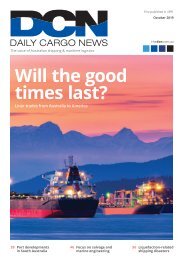DCN September Edition 2019
Create successful ePaper yourself
Turn your PDF publications into a flip-book with our unique Google optimized e-Paper software.
REEFER TRADES<br />
Shipping line MSC claims to have one of the largest and most advanced reefer fleets in the world<br />
“There is also a change in the trade routes… what you saw in<br />
past was a more significant trade route from south to north… but<br />
now it’s more east to west and more growth in inter-Asia markets<br />
which is sucking up equipment from more developed markets and<br />
keeping it there.”<br />
With 9.5% market share of the reefer business globally (Intra<br />
Regional Trade Asia trade excluded), Hapag-Lloyd achieved<br />
throughput of 781,000 TEU in 2018. It also invests in a new reefer<br />
building program, adding 13,420 to its fleet this year.<br />
“Hapag-Lloyd’s reefer fleet is about 100,000 units,” national<br />
reefer and special cargo manager for Hapag-Lloyd, Mehernosh<br />
Bhiwandiwalla, says.<br />
He tells <strong>DCN</strong> that the biggest trend in the reefer business<br />
globally is the modal shift from conventional refrigerated ships to<br />
reefer containers for perishable goods.<br />
“Is the demise of refrigerated ships going to be accelerated due<br />
to IMO 2020? That would force containership growth quicker than<br />
expected,” he says.<br />
Mr Bhiwandiwalla says IMO 2020 is also a challenge for<br />
shipping lines.<br />
“All the lines are working towards this so that we are ready by<br />
the start date and that is a significant cost to the liner business.<br />
This is mainly reflected in fuel costs and looking at other<br />
technology like LNG or EGCS.”<br />
The successful cost recovery is what Hapag-Lloyd calls the<br />
“marine fuel surcharge,” according to Mr Bhiwandiwalla.<br />
Although he could not provide any indication of what the<br />
surcharge will be, Mr Bhiwandiwalla says the process would be<br />
a “transparent and easy method of calculation” for customers<br />
to understand.<br />
Is the demise of refrigerated ships going<br />
to be accelerated due to IMO 2020?<br />
John Bannister, Seaco<br />
“That trend continues and also the high demand for foodstuffs<br />
due to the growing world population, driven also by the wealthy<br />
middle class in Asia mainly China keeps reefer trade in positive<br />
year-on-year trade,” he says.<br />
Reefer containers offer numerous advantages over refrigerated<br />
ships, mostly through access to the sheer number of containers<br />
and the number of ports that liner vessels visit. In addition, reefers<br />
enable easier transport at the other end, where containers can go<br />
straight from the wharf to markets or businesses.<br />
Mr Bannister says there are question marks over the implications<br />
of IMO 2020 and whether that will cause slow steaming which<br />
would in turn affect the demand for containers.<br />
VIEW FROM AUSTRALIA<br />
From the Oceania perspective, the reefer market is quite strong and<br />
mainly driven by exports, according to Hapag-Lloyd.<br />
“In 2018 we feel the export volume was 560,000 TEU, this<br />
is the volume mainly from Australia and New Zealand,” Mr<br />
Bhiwandiwalla says.<br />
“We are seeing the Oceania market growing positively by 4-5%<br />
annually and expect that trend to continue. The main reefer<br />
commodities continue to be meat, fruit and veg and dairy. We have<br />
seen new strong demand from markets in Asia.<br />
“Where we have seen there has been growth is in exports from<br />
Australia to China, almost 8% over the last few years, due to the<br />
population growth in the middle class in China. They have a great<br />
desire and appetite for Australian fresh produce - meat, wine,<br />
cheese, dairy – and that has continued to grow.”<br />
Richard Fedden, regional VP marketing Oceania at Seaco<br />
says, “Majority of the market in Australia is the 20-foot market.<br />
Domestically we use 1-2% of the [Seaco] reefer fleet but we also<br />
have reefers coming in through carriers like CMA CGM and MSC<br />
who move their reefers into the market.”<br />
MSC<br />
48 <strong>September</strong> <strong>2019</strong><br />
thedcn.com.au
















